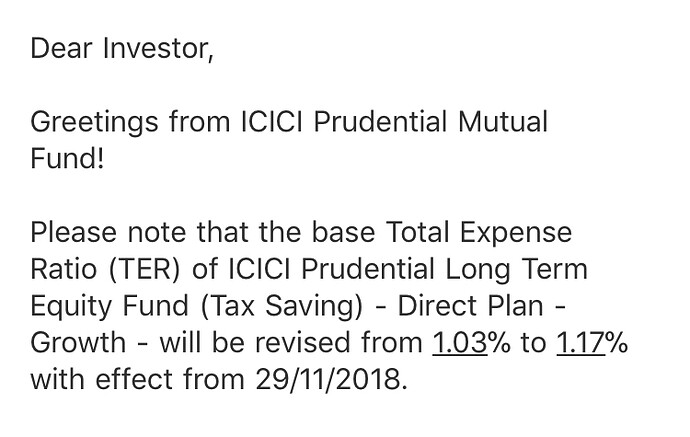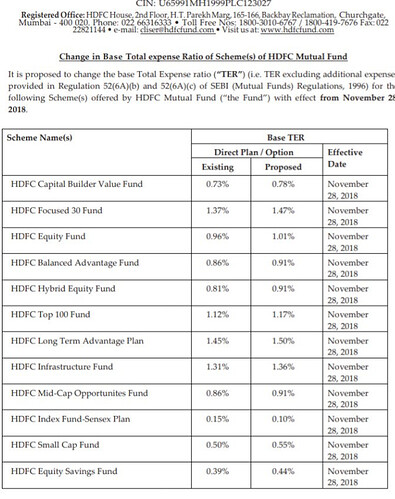Post III - Unit economics for an AMC (HDFC AMC in particular)
| Expense Ratios (after knocking off GST) |
|
|
|
|
|
|
|
|
| HDFC AMC |
|
|
|
AAUM Oct 2017 |
|
|
Fee |
|
| Category |
Direct |
Regular |
|
Direct |
Regular |
|
Direct |
Regular |
| Liquid/Money Market |
0.15% |
0.30% |
|
22,299 |
13,771 |
|
33.45 |
41.31 |
| Gilt |
0.30% |
0.60% |
|
1,494 |
1,287 |
|
4.48 |
7.72 |
| FMP |
0.25% |
0.45% |
|
8,745 |
6,791 |
|
21.86 |
30.56 |
| Other Debt |
0.70% |
1.20% |
|
38,309 |
50,391 |
|
268.16 |
604.69 |
| ELSS |
1.04% |
1.79% |
|
576 |
7,648 |
|
5.99 |
136.90 |
| Non ELSS |
1.25% |
2.05% |
|
15,816 |
58,811 |
|
197.70 |
1205.63 |
| Balanced |
1.00% |
1.81% |
|
4,704 |
46,879 |
|
47.04 |
848.51 |
| FoF |
0.10% |
1% |
|
39 |
223 |
|
0.04 |
2.23 |
|
|
|
|
91,982 |
1,85,801 |
|
579 |
2,878 |
By this logic, the total expense ratio charged over the total AUM should be 3400-3500 Cr but HDFC AMC’s top line for FY 2018 was only 1800 Cr. How does this translate? Answer below
Let us consider 3 funds of HDFC AMC - HDFC Top 200 fund, HDFC Short Term Opportunities fund and HDFC Corporate Debt opportunities fund
All numbers from the individual scheme annual filings (these are available on website)
| 2018 - HDFC Top 200 Fund AUM |
|
|
|
|
|
2018 - HDFC Short Term Opportunities Fund |
|
|
|
|
|
|
2018 - HDFC Corporate Debt Opportunties Fund |
|
|
|
|
|
|
Direct |
Regular |
|
|
|
|
Direct |
Regular |
|
|
|
|
|
Direct |
Regular |
|
|
|
| AUM |
2160 |
12430 |
|
|
|
AUM |
6055 |
3533 |
|
|
|
|
AUM |
2654 |
11128 |
|
|
|
|
|
|
|
|
|
|
0.22% |
0.37% |
|
|
|
|
|
0.92% |
1.72% |
|
|
|
| Expense Ratio |
33.05 |
282.16 |
315.209 |
2.23% |
|
Expense Ratio |
13.321 |
13.0721 |
26.39 |
0.28% |
|
Expense Ratio |
|
24.42 |
191.40 |
215.82 |
1.57% |
|
| Management Fee |
|
|
175.28 |
1.20% |
54% |
Management Fee |
|
|
15.52 |
0.16% |
59% |
Management Fee |
|
|
|
102.96 |
0.75% |
48% |
| Service Tax |
|
|
30.2 |
|
|
Service Tax |
|
|
2.69 |
|
|
Service Tax |
|
|
|
18.03 |
|
|
| Transfer Agent Fee |
|
|
10.95 |
|
|
Transfer Agent Fee |
|
|
2.99 |
|
|
Transfer Agent Fee |
|
|
|
3.86 |
|
|
| Custodian Fee |
|
|
0.78 |
|
|
Custodian Fee |
|
|
0.68 |
|
|
Custodian Fee |
|
|
|
0.93 |
|
|
| Trustee Fee |
|
|
0.13 |
|
|
Trustee Fee |
|
|
0.085 |
|
|
Trustee Fee |
|
|
|
0.11 |
|
|
| Commission |
|
|
103 |
0.83% |
|
Commission |
|
|
4.71 |
0.13% |
|
Commission |
|
|
|
85.85 |
0.77% |
|
| Investor Education |
|
|
3.01 |
|
|
Investor Education |
|
|
2.01 |
|
|
Investor Education |
|
|
|
2.58 |
|
|
| Other Operating Exp |
|
|
1.57 |
|
|
Other Operating Exp |
|
|
0.08 |
|
|
Other Operating Exp |
|
|
|
0.06 |
|
|
Direct Plan AUM * Direct plan expense ratio + Regular Plan AUM * Regular Plan expense ratio = total expense charged by scheme to all investors
Management Fee is what gets credited to HDFC Asset Management company as revenue, commission is distributors is charged off at scheme level.
Hence Management Fee ratio = Management Fee collected by HDFC AMC/Total expense ratio charged to customers
Working the numbers one can now understand how the top line reported by HDFC AMC is 1800 Cr and not 3400 Cr.
This commission paid to the distributors is discretionary - AMC can increase/lower this based on how they want to garner AUM and manage their financials. Key point is AMC can lower this to pass on the expense ratio cuts initiated by the regulator
This management fee conversion ratio appears to be on similar lines across AMC’s - this can be verified from ICICI Pru AMC and RMF AMC filings as well amongst others. Another key thing to understand is that direct plans do not have to pay commission to distributors from the scheme, as % of direct AUM increases, the management fee ratio will increase as well
Once one understands this, the P&L is very easy to understand and one can isolate the key variables there. Coming to the P&L, most important other expenses are these -
| Other Expenses |
2010 |
2011 |
2012 |
2013 |
2014 |
2015 |
2016 |
2017 |
2018 |
| Brokerage/Incentive/Fee/MF Expenses |
66.99 |
148.93 |
114.96 |
121.12 |
150.64 |
173.44 |
456.62 |
419.27 |
368.69 |
| % of Sales |
11.12% |
22.12% |
18.15% |
16.92% |
17.55% |
16.96% |
31.65% |
28.33% |
20.95% |
| % of AUM |
0.08% |
0.17% |
0.13% |
0.12% |
0.13% |
0.11% |
0.26% |
0.18% |
0.12% |
| Business Promotion |
17.04 |
10.31 |
8.83 |
11.64 |
17.71 |
25.76 |
37.92 |
52 |
78.48 |
| % of Sales |
2.83% |
1.53% |
1.39% |
1.63% |
2.06% |
2.52% |
2.63% |
3.51% |
4.46% |
This is where one can understand why the regulator has been disciplining the AMC repeatedly. Brokerage charges when you manage this kind of AUM will hardly be 5 to 6 bps. Which means approx another 5-6 bps of AUM is going into “distributor friendly activities” in addition to the Business promotion line item which can be utilized for this purpose as well. A good chunk of this is discretionary as well and can be rationalized if the margins come under pressure.
SEBI in the TER paper has also mandated that AMC move to total trail commission model and that all marketing expenses have to be charged to the scheme and not to the AMC. Hence creative ways of incentivising distributors will be forced to come down going forward
Key Message - One needs to understand that a good part of the marketing/distribution expenses are discretionary (though competitive forces will ensure some spends here) for an AMC. If push comes to shove they have enough means at their disposal to be able to preserve margins and keep financials healthy.
Read this in combination with HDFC AMC statement in their investor presentation that “most impact of the TER cut will be passed on”, they very well know what they are saying. As AMC’s garner more direct plan AUM, their ASP spends will go up somewhat while distribution expenses will come down.
In my view AMC’s have considerable pricing power due to the logic given above
Dependence on HDFC Bank
HDFC Bank is responsible for 10% of the AMC AUM but takes home a much bigger chunk of the commission paid out (this is a SEBI mandated disclosure on the site)
| Commission to ARN |
2014 |
2015 |
2016 |
2017 |
2018 |
| HDFC Bank |
52.93 |
114.17 |
90.65 |
167.89 |
278 |
| ICICI Bank |
6.38 |
13.54 |
10.33 |
10.43 |
20 |
| Citibank |
26.65 |
40.14 |
19.39 |
20.23 |
29.64 |
| HSBC |
13.52 |
21.63 |
14.08 |
13.95 |
19.97 |
| StanC |
7.5 |
6.87 |
4.18 |
3.8 |
14.09 |
| IIFL Wealth |
64.08 |
86.55 |
42.48 |
51.37 |
44.62 |
| NJ Invest |
26.82 |
52.08 |
51.94 |
68.99 |
128.48 |
| Kotak Bank |
7.95 |
42.87 |
16.54 |
16.4 |
31.04 |
| Axis Bank |
8.8 |
7.91 |
6.25 |
10.48 |
20 |
| Karvy |
5 |
6.29 |
5.32 |
6.88 |
18 |
| ICICI Sec |
14.84 |
27.37 |
18.25 |
28.61 |
51.72 |
| Deustche Bank |
4.48 |
12.69 |
6.74 |
9.41 |
11.65 |
| HDFC Sec |
0.55 |
1.03 |
1.77 |
5.28 |
18.36 |
| Credit Suisse |
24.2 |
26.46 |
64.36 |
17.6 |
10.33 |
| Julius Baer |
13.16 |
17.59 |
7.07 |
14.29 |
18.93 |
| Anand Rathi |
1.7 |
8 |
1.9 |
0.82 |
12.23 |
| Total |
|
741 |
584.98 |
|
1201.95 |
To some extent is is understandable since HDFC bank branches are mostly selling high margin funds to retail customers. Even then this dependence is reasonably high as of now, this number is in fact much higher in case of ICICI AMC towards ICICI Bank.
Summarizing the impact of all forces on the AMC business -
Threat due to investors moving away is average - based more on performance than on cost
Threat from replacement - HNI segment might move to PMS and AIF, this will get countered due to Retail inflows though
Threat from Suppliers - Minimal
Threat of new entrants - Not high since this is a leading player and has held onto market share. ETF threat not high right now
Competitive Intensity - High but brand name, credible track record and distribution are the moats involved
Regulatory threat - Very high and immediate, expense ratios will only trend down over time but I see pricing power
An AMC business has much more going for it than it appears at first look.
Some of these data points were a pleasant surprise to me as well though I have worked as a wealth manager for 7+ years.



